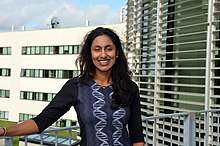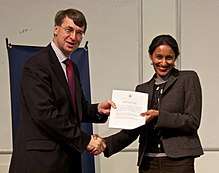Hiranya Peiris
Hiranya V. Peiris is a British astrophysicist at University College London, best known for her work on the cosmic microwave background radiation. She was one of 27 scientists who received the Breakthrough Prize in Fundamental Physics in 2018 for their "detailed maps of the early universe."
Prof. Hiranya Peiris | |
|---|---|
 Peiris in 2016 | |
| Born | |
| Nationality | British |
| Education | University of Cambridge and Princeton |
| Occupation | Astrophysicist |
| Employer | UCL, Stockholm University |
Education
Peiris was born in Sri Lanka. She completed her undergraduate studies in Physical Natural Sciences at the University of Cambridge in 1998,[1] at New Hall, now known as Murray Edwards College.[2][3] She earned a PhD at Princeton at the Department of Astrophysical Sciences, where she first worked on the Wilkinson Microwave Anisotropy Probe (WMAP).[4][5] She went on to work at the Kavli Institute for Cosmological Physics at the University of Chicago as a Hubble fellow.[4]
Research and career
Having held several competitive postdoctoral fellowships,[6] in 2007 Peiris returned to the University of Cambridge as an STFC Advanced Fellow and was awarded a Junior Research Fellowship at King's College, Cambridge in 2008. In 2009, Peiris won a Leverhulme Trust award for cosmology and secured a faculty position at University College London.[7]
She is currently Professor of Astrophysics at UCL[8] and also the Director of the Oskar Klein Centre for Cosmoparticle Physics in Stockholm.[9]
In 2012, the WMAP team (including Peiris) won the Gruber Cosmology Prize for their "exquisite measurements of anisotropies in the relic radiation from the Big Bang---the Cosmic Microwave Background".[10] WMAP's results on cosmic inflation, which Peiris contributed to, were described by Stephen Hawking as "the most exciting development in physics during his career".[11]
She was skeptical about the 2014 announcement of the discovery of primordial gravitational waves in the cosmic microwave background: "If they announce gravitational waves on Monday then I will need a great deal of convincing. But if they do have a robust detection ... Jesus wow! I'll be taking next week off." Mike Hockney used this quote to illustrate that even top scientists need convincing because scientific discoveries are always just interpretations of results.[12] Her skepticism proved well-founded: on January 30, 2015, a joint analysis of BICEP2 and Planck data was published and the European Space Agency announced that the signal can be entirely attributed to dust in the Milky Way,[13] though (non-primordial) gravitational waves have since been detected by different experiments.
In 2016, Peiris was elected as a fellow of the American Physical Society and Vice President of the Royal Astronomical Society.
In 2018, Peiris was awarded the Hoyle Medal and Prize of the UK Institute of Physics for “her leading contributions to understanding the origin and evolution of cosmic structure."[14]
In 2020 Peiris was awarded the Göran Gustafsson Prize in physics by the Göran Gustafsson Foundation and the Royal Swedish Academy of Sciences "for her innovative research on the dynamics of the early universe, which links cosmological observations to basic physics”. [15] She was also elected as a member of STFC Council, the senior strategic advisory body of the research council that funds particle physics and astronomy in the United Kingdom. [16]
Public engagement
Alongside academic talks, Peiris gives public lectures about cosmology.[17][18] She has written articles and given interviews for both radio and print media.[19] She has appeared on podcasts, television programs and the national news.[20] In 2013 she gave a talk at TEDxCERN, "Multiplying Dimensions."[21] That year she was selected as one of Astronomy's top ten rising stars by Astronomy Magazine.[22]
In 2014, the pseudonymously-written Ephraim Hardcastle diary column in the Daily Mail claimed that Peiris (along with Maggie Aderin-Pocock) had been selected to discuss results from the Background Imaging of Cosmic Extragalactic Polarization 2 (BICEP-2) experiment on BBC Newsnight because of her gender and ethnicity. These comments were condemned by mainstream media, the Royal Astronomical Society and Peiris' employer, University College London,[23][24][25] and the Daily Mail and its column backed down within days.[23][24] Peiris offered a rebuttal, "Groundbreaking science is blind to prejudice" in Times Higher Education.[26]
In 2017, Peiris collaborated with artist Penelope Rose Cowley to create artwork entitled "Cosmoparticle".[27]
Awards

2020 - Göran Gustafsson Prize in Physics, Göran Gustafsson Foundation and the Royal Swedish Academy of Sciences[15]
2018 - Fred Hoyle Medal and Prize, Institute of Physics[14]
2018 - Breakthrough Prize in Fundamental Physics[28]
2014 - Buchalter Cosmology Prize[29]
2012 - Gruber Prize for Cosmology, Gruber Foundation [10]
2012 - Fowler Prize, Royal Astronomical Society[30]
2009 - Philip Leverhulme Prize, Leverhulme Trust[31]
2007 - Halliday Prize, STFC[32]
2007 - Kavli Frontiers Fellow, National Academy of Sciences[33]
One of a team awarded the 2018 Breakthrough Prize for Fundamental Physics
Peiris was a member of the 27-person team awarded the 2018 Breakthrough Prize in Fundamental Physics.[34] The US$3 million award was given for the detailed maps of the early universe generated from WMAP.[35] WMAP is a NASA explorer mission that was launched in 2001, which has transformed modern cosmology.[36][37]
Publications
A list of Peiris' publications can be found here.
See also
References
- Thompson, Michael T J (2005). Advances In Astronomy: From The Big Bang To The Solar System. World Scientific. p. 122. ISBN 178326019X.
- "Career Path: Exploring fingerprints from the Big Bang". Murray Edwards College - University of Cambridge. 2015-11-19. Retrieved 2019-02-15.
- UCL (2018-01-26). "Hiranya Peiris". Cosmoparticle Initiative. Retrieved 2019-02-15.
- "Iris View Profile". iris.ucl.ac.uk. Retrieved 2017-12-12.
- Thompson J Michael T (26 October 2005). Advances In Astronomy: From The Big Bang To The Solar System. World Scientific. pp. 99–. ISBN 978-1-78326-019-5.
- "Dr Hiranya Peiris". Astronomy & Geophysics. 53 (1): 1.37. 2012-02-01. doi:10.1111/j.1468-4004.2012.53136_7.x. ISSN 1366-8781.
- "The Leverhulme Trust, 2009 Award Winners" (PDF). Archived from the original (PDF) on 2016-04-26. Retrieved 2017-12-12.
- "Prof Hiranya Peiris". www.ucl.ac.uk. Retrieved 2018-01-25.
- "People". www.okc.albanova.se. Retrieved 2017-12-12.
- "2012 Gruber Cosmology Prize Citation | The Gruber Foundation". gruber.yale.edu. Retrieved 2017-12-12.
- "2013 Smart Guide: New maps to rein in cosmic inflation". New Scientist. Retrieved 2017-12-12.
- Mike Hockney (29 March 2016). How to Create the Universe. Lulu Press, Inc. pp. 279–. ISBN 978-1-326-61200-9.
- Cowen, Ron (30 January 2015). "Gravitational waves discovery now officially dead". Nature. doi:10.1038/nature.2015.16830.
- Physics, Institute of. "2018 Fred Hoyle Medal and Prize". www.iop.org. Retrieved 2018-07-26.
- Physics Department, Stockholm University. "Göran Gustafsson Prize". www.fysik.su.se. Retrieved 2020-03-18.
- Research and Innovation, UK. "STFC Council member". www.ukri.org. Retrieved 2020-03-18.
- The Royal Institution (2016-08-10), Cosmology: Galileo to Gravitational Waves - with Hiranya Peiris, retrieved 2017-12-12
- "Hiranya Peiris | In the Dark". telescoper.wordpress.com. Retrieved 2017-12-12.
- "Multiverse Proof Possibility From Colliding Universes | Quanta Magazine". Quanta Magazine. Retrieved 2017-12-12.
- "February 2011 - show notes". www.jodcast.net. Retrieved 2017-12-12.
- "TEDxCERN | TED". www.ted.com. Retrieved 2017-12-12.
- "Astronomy Magazine names "Rising Stars of Astronomy"". www.earlyuniverse.org. Retrieved 2017-12-12.
- "Scientist (PhD in astrophysics) shocked by reference to her ethnicity". The Independent. 2014-03-21. Retrieved 2017-12-12.
A Mail spokesman said the paper fully accepted that the women were highly qualified in their field and that that was the reason they were chosen for interview. Yesterday’s Ephraim Hardcastle column stated: “I accept without questions that both ladies are highly qualified.”
- Meikle, James (2014-03-21). "Daily Mail accused of insulting top female scientists". The Guardian. ISSN 0261-3077. Retrieved 2017-12-12.
A Mail spokesman made it clear that the paper fully accepts that the women were highly qualified in their field and that was the reason they were chosen for interview. The Mail is in contact with Professor Price.
- Smith, Keith. "RAS statement on Hiranya Peiris and Maggie Aderin-Pocock". www.ras.org.uk. Retrieved 2017-12-12.
- "Groundbreaking science is blind to prejudice". Times Higher Education (THE). 2014-03-27. Retrieved 2017-12-12.
- "COSMOPARTICLE". Art by Penelope Rose Cowley. Retrieved 2017-12-12.
- "Awards Won - Astrophysics Science Division - 660". science.gsfc.nasa.gov. Retrieved 2017-12-12.
- "Buchalter Cosmology Prize for Bubble Collision Simulations". www.earlyuniverse.org. Retrieved 2017-12-12.
- Massey, Robert. "RAS honours leading astronomers and geophysicists". www.ras.org.uk. Retrieved 2017-12-12.
- "Young researchers win Philip Leverhulme Prizes". Astronomy & Geophysics. 50 (6): 6.08. 2009-12-01. Bibcode:2009A&G....50f...8.. doi:10.1111/j.1468-4004.2009.50604_16.x. ISSN 1366-8781.
- "Dr Hiranya Peiris - Research Councils UK". www.rcuk.ac.uk. Retrieved 2017-12-12.
- "Kavli Frontiers of Science Alumni". National Academy of Sciences.
- "Breakthrough Prize – Fundamental Physics Laureates – Norman Jarosik and the WMAP Science Team". breakthroughprize.org. Retrieved 2017-12-12.
- "Professor Hiranya Peiris shares Breakthrough Prize for early universe mapping". www.ucl.ac.uk. Retrieved 2017-12-12.
- "Wilkinson Microwave Anisotropy Probe (WMAP)". map.gsfc.nasa.gov. Retrieved 2017-12-12.
- Massey, Robert. "RAS Vice-President Professor Hiranya Peiris shares Breakthrough Prize in Fundamental Physics". www.ras.org.uk. Retrieved 2017-12-12.